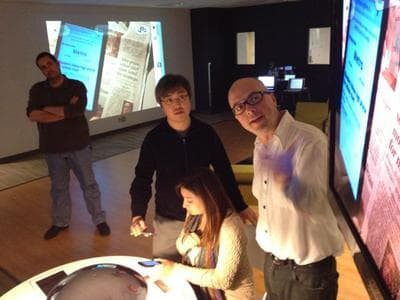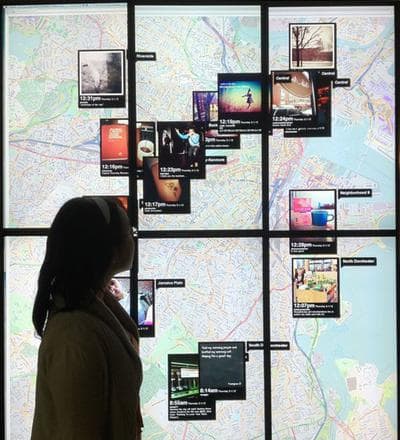Advertisement
Globe Lab: Breathing New Life Into Journalism
Resume
As newspapers around the country struggle to be profitable in the digital age, The Boston Globe is taking some ambitious steps to marry old and new journalism.
The Globe created what it calls the Globe Lab, a space where employees are encouraged come up with ways to breathe life back into the newspaper industry.
“Hopefully we'll invent the new economic lifeblood of The Boston Globe in this room,” said Chris Marstall, the lab’s creative technologist. "What it means to publish the news is no longer clear at all. So we're trying to have this space be a nexus for every conceivable platform."
Ironically, the lab is located where the paper's classifieds department used to be. It's a large, open space filled with various types of technology to test how news content might be used.
In one corner there's a kitchen table and sofa set up to test how Globe content might be read at home. Another area looks like a bar to test how groups might use news content on large TV screens. There is also software being developed here that could not only change the ways news is delivered, but how it's defined.
Marstall shows me what’s known as Snap — one of the lab’s biggest capital investments. Snap is a huge six-screen map of Boston that posts images from the photo-sharing app Instagram, ranging from graduation photos to pizza.

"What this is, conceptually, for me, is the Globe's mission has been to tell you what people in Boston are doing now-ish. This does that,” Marstall said.
But is a picture of pizza news?
“Read the caption. It says 'I paid $16 for pizza that looks like grass. Damn tasty though.' Sounds like a restaurant review to me,” Marstall said. "It’s sort of a radically different idea of what a newspaper is.
"In this vision, there are no editors. All we have done as a newspaper here is design a piece of software and presented it. Is that the future of the news? I don't know."
Snap is one of about 11 types of software that have been developed at Globe Lab, although none are commercially available yet. There's also what they call an "incubator," where about half a dozen technology startups have been given desk space for free.
"People walk by and say that looks like Google in there. I love it when people say that,” said Jeff Moriarty, vice president of digital products at the Globe. Moriarity developed Globe Lab and says newspapers and all media have to work closely with technologists.
“We're competing to hire people who would work at Google or at some other place," Moriarty said. "So we have to try to create an environment that spurs creativity and innovation."
Some of the startups in the lab are working on products directly related to journalism — but not all of them.
Muckrock, for example, is a company that helps people file Freedom of Information Act requests for government documents. And a company called Supermechanical that makes a device known as Twine which helps consumers link their physical and online worlds.
Company co-founder David Carr says this panoply of creative projects can only help everyone involved.
"There are a lot of smart people in this space and they're bringing in more smart people from different avenues and skillsets,” Carr said. “The overall product and the quality and quantity of that collaboration is probably worth it even if you can't point to the bottom line and say, 'We had this company here and we did this thing.' I think it's more about these intangibles."
The Globe is also using some of its own people in new ways. Sports reporter Chris Gasper hosts a live sports show from a TV studio set up at the paper. The show is broadcast online three times a week. Media analyst Ken Doctor says the Globe and all media organizations will have to cross platforms and blend content to survive.

"By 2015, 2016, these media companies that survive and prosper will all be multimedia,” Doctor said. “They may start out as newspapers or TV or radio — it doesn't matter what the roots are. What readers or listeners or viewers want is what makes the most sense, it could be audio, video or words.
"All of these steps, a sports program by the Globe, for example, is just one more step toward a real multimedia future."
That may be the future, but it appears audiences are most attracted to what’s soon to become a thing of the past: local newspaper content. A recent Newspaper Association of America survey says 74 percent of all Internet users rely on local newspaper sites as their key source for news and information.
So old fashioned news content still appears to be the main attraction but it, and its offices, are starting to look a lot different.
This program aired on May 29, 2012.
